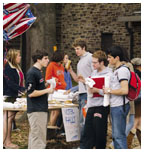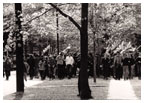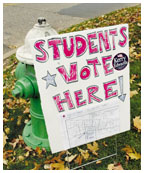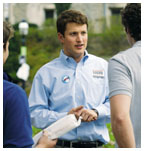December 8, 2004: Features
From left, in foreground, Alex Fiorentino ’07, Michael Cutright ’08, and Mike Hidalgo ’08 eat hoagies and talk politics at a student get-out-the-vote effort on Election Day. (Frank Wojciechowski)
Students march against the war in Southeast Asia, May 1970. (Princeton University Archives)
Leaders of the Workers’ Rights Organizing Committee David Tannenbaum ’01, left, and Nicholas Guyatt *03, before taking their cause to a meeting of the Council of the Princeton University Community in May 2001. (Frank Wojciechowski)
Sign of the times, Election Day 2004 (Frank Wojciechowski)
Campus Republican leader Evan Baehr ’05 campaigns for a seat on Borough Council on Election Day. (Frank Wojciechowski)
|
Off
the barricades
Are today’s students uninterested in world
affairs, or just involved in different ways?
By Mark F. Bernstein ’83
Where have all the marchers gone?
Long time passing.
Where have all the activists gone?
Long time ago.
The answer to that question, paraphrased from the old antiwar folk song “Where Have All the Flowers Gone?” seems to be: Gone to Firestone, every one. Or Frist. Or dance rehearsal. Or sports practice.
One place you did not find them this fall was on the barricades. In many respects, students’ apparent quietude during this most polarizing of political seasons was not unique to Princeton. There have been few demonstrations, either for or against the war in Iraq (or indeed, on any other issue), on college campuses anywhere in the country. In last month’s election, voters aged 18—29 had a record turnout — but so did everyone else — and these voters comprised approximately the same portion of the electorate as they did four years ago. About 42 percent of U.S. citizens between 18 and 24 voted, according to the Center for Information and Research on Civic Learning and Engagement at the University of Maryland.
Yet with issues of war and peace so immediate these days, one is tempted to ask whether Princeton students are quiet because they are content — part of what Richard Nixon once called the “silent majority” — or because they are simply uninterested.
“I’m not following [the election],” said junior Caitlin Abidin, one afternoon in late September. “I don’t know where to go to find out. I hear Kerry is wishy-washy,” Abidin said, though she was skeptical of President Bush’s desire to remake the political map of the Middle East. “I don’t know what gives us the right to impose democracy on others,” she said. “It took us 200 years.”
Abidin’s classmate, Neal Chatterjee, keeps up with the news online but did not have the time to study the candidates’ positions closely, he said. “I still don’t feel connected to the war.”
Princeton has never been the most politically active campus, but certain issues have grabbed the attention, and particularly the time, of its undergraduates. During the Vietnam War, students boycotted classes and the P-rade to tear up their draft cards. In the 1980s, a small band of students routinely marched around Nassau Hall demanding that the University divest itself of investments in companies doing business with the apartheid government of South Africa. As recently as three years ago, a group of students, working with labor unions, tried to raise awareness of what they viewed as underpayment of University service employees, staging rallies around the campus.
This year, the war and the election have interested students but failed to incite great passion. The largest local antiwar organization, the Princeton Peace Network, is an amalgamation of students and townspeople; according to Nisreen Salti, a graduate student in economics, PPN was most active on campus shortly after the 9/11 attacks, when members marched from Frist to Palmer Square to protest the incipient American retaliation against the Taliban regime in Afghanistan. A presidential-debate-watching party at the Frist Campus Center in October drew about 400 students, though many acknowledged that they were lured, in part, by free pizza. The mood was raucous, much as one would find in a crowd watching a televised prizefight. Students’ motives for attending varied. “I came to watch the majority reaction, to see people in general,” said Jonathan Li ’08. “The food was definitely a plus.” Somewhat more dutifully, junior Roxanne Gaudiel explained, “My professor said we had a moral obligation to attend.”
“Princeton has this informal motto — ‘Princeton in the nation’s service and in the service of all nations,’” said Peter Wolanin ’94, a post-doctoral researcher in molecular biology who is active in the Princeton Peace Network, “but the majority of students who are going into careers in consulting and investment banking are not really doing what Princeton should be training its students to do.” Wolanin said he had little time for political issues as an undergraduate and first became actively engaged in politics as a member of the graduate student employees’ union while pursuing his master’s degree at the University of Michigan.
Writer David Brooks found much the same sort of detached atmosphere on the Princeton campus almost four years ago, which he described in an article for the Atlantic Monthly titled “The Organization Kid.” Brooks reported seeing no Bush or Gore signs at Princeton during the last presidential election, just as there was a dearth of visible support for Bush or Kerry this fall. Students, he wrote, seemed more pragmatic than passionate, whether about politics, career choices or anything. “They feel no compelling need to rebel — not even a hint of one,” Brooks wrote of the students he observed. “They not only defer to authority; they admire it.”
Ask students why they don’t get involved and they give variations on the same theme: They’d like to, but they’re just too busy. Between freshman orientation, Greek rush, dance rehearsal, sports, and just trying to have a social life, leaving aside the tremendous academic pressure, who has time to protest a war so far away? Students routinely talk about “the bubble” to describe the self-contained world of the Princeton campus. “You can go weeks here and not even set foot on Nassau Street,” said Deborah Arotsky ’06, president of the Princeton Israel Public Affairs Committee (PIPAC), a group dedicated, according to its Web site, to “promoting political activism on Israel’s behalf within the University community and beyond.” (Graduate students, whose lives are no less hectic but who tend to be excluded from the social bubble of undergraduate life, are over-represented in campus political and activist groups, noted the Peace Network’s Nisreen Salti. These students often seek out political organizations for their social opportunities as well as their agendas. Older than undergraduates, graduate students also tend to be more politically mature, with more ties to the real world. Many are not American citizens; Salti suggests they have a greater tradition of political activism and familiarity with global issues.)
Karis Gong ’06, president of Whig-Clio, attributes the lack of involvement today, in part, to increasing “cultural fragmentation” due to Princeton’s growing diversity. Campus life is so diverse, Gong suggested, that it is difficult to bring students together in large numbers under a single banner for any particular cause. Gong also pointed to student isolation, psychological as well as physical. “I don’t know if people become desensitized, but there isn’t a draft and students aren’t afraid that they or their friends would be drafted,” Gong said.
It wasn’t always this way. Dr. Hal Strelnick ’70, who helped lead the campus strike in his senior year, recalled that students paid little attention to the Vietnam War when he arrived on campus in 1966, notwithstanding the draft, and that the process of engagement, leading to radicalization, was slow. But there were several galvanizing events: the 1968 presidential election campaign, particularly the primary candidacy of Minnesota Senator Eugene McCarthy; the assassinations of Martin Luther King Jr. and Robert F. Kennedy; and the Soviet invasion of Czechoslovakia later that spring. In April 1970, a small group of student protesters disrupted a speech on campus by Interior Secretary Walter Hickel, shouting, “Talk about the war!” and other slogans. But the match that lit the fuse of campus unrest, Strelnick said, was President Nixon’s announcement a few weeks later of a secret bombing campaign that expanded the war into Cambodia. That event, which was quickly followed by the shooting of student demonstrators at Kent State University, convinced many that the war, far from drawing to a close, was escalating. “Learning the hard way that the government doesn’t always tell you the truth took a long time,” Strelnick said.
Even at a relatively quiet campus such as Princeton’s, the reaction was incendiary. Within a half hour of Nixon’s televised speech, 2,500 students and faculty members had gathered in the chapel to discuss a response. Nearly 4,000 students staged a mass protest in Jadwin Gym several days later. In a “Rite of Protest” at the chapel, 175 students heeded an invitation by Dean of the Chapel Ernest Gordon “to place your draft cards on the altar as a gift to God.” Eighty percent of students boycotted the last day of classes to protest the war, the faculty voted to permit students to postpone finishing their spring academic work until fall, and two students were charged with firebombing the Princeton ROTC office. Several eating clubs cancelled Houseparties for the first time since World War II, while graduating seniors declined to march in the P-rade as a way of getting the attention of older alumni, and canceled Class Day activities in favor of “teach-ins” to discuss the war.
Although media interest in student activism fell off after these events, Strelnick said, the students’ own interest did not. Princeton instituted the fall break that year to give students a chance to work on political campaigns and put their interest into action. Many cast their first ballot two years later in the presidential contest between Nixon and George McGovern.
Like other student activists from earlier generations, Strelnick dismissed the argument that today’s undergraduates are too busy to take a stand on important public issues. “How people spend their time reflects their priorities. Everyone has the same 24-hour day,” he said. Sally Frank ’80, now a law professor at Drake University best known at Princeton for her lawsuit against all-male eating clubs, was a dedicated activist during her undergraduate years, for campus causes ranging from the anti-apartheid movement to the lack of locks on women’s bathroom doors. She suggested that students can be engaged if their classmates try hard enough to rouse them. “You always feel overwhelmed by what you’re doing,” said Frank, whose political sensitivities had developed well before she arrived at Princeton. “We basically made world issues into the campus issues.”
Two decades after Frank graduated, David Tannenbaum ’01 formed the Workers’ Rights Organizing Committee during his junior year to fight for better pay for University employees. Tannenbaum did not become politically active until he had summer internships with Ralph Nader ’55’s office and the organization Common Cause. “Coming back to Princeton, where none of that [sort of political activism] was going on, I became so frustrated,” Tannenbaum recalled. At its peak in the spring of 2001, the WROC staged demonstrations around campus and at the P-rade. But Tannenbaum concedes that the group faded shortly after he and the group’s other founders graduated, a common occurrence for new student organizations. The long-term success of any political movement “depends on how much time the organizers devote to training the next generation [of leaders]. ... There’s no institutional support at Princeton for student activism,” he said, though he was quick to add that there is none at most universities. The few politically engaged campuses, such as Yale (where Tannenbaum is now a law student) tend to be located in bigger cities, where “you can’t help but see the effects of poverty,” he said.
Some observers suggest that student involvement has not disappeared — it has simply evolved. Princeton students take on projects with clear objectives and an eye toward effectiveness. Concerned about the on-going genocide in Sudan, for example, 10 student performing groups got together in November to stage a fund-raising concert. The most visible student political organization during the fall election season was the voter-registration campaign known as Princeton Votes, which was run jointly by the campus Democrats and Republicans. P-Votes tables were common sights at Frist, underclass dining halls, and on Prospect Street, and the effort succeeded in registering more than 1,300 new voters, according to Frances Schendle ’06, a member of the College Democrats who helped run the voter-registration drive. Once the drive ended, the groups focused their efforts on getting students to the polls and to distribute leaflets or volunteer on campaigns in New Jersey and Pennsylvania.
“I think people care about the war,” insisted Laurie Williams ’06. “They just don’t feel that protest is the way they want to express their dissent. People feel that voting is the way to do something about it.”
Evan Baehr ’05, a Republican who supports the war, thinks the lack of demonstrations on campus reflects a more mature outlook on politics. “There is a shift away from a visual display of protest to a more rational, calm, formal opposition to the war,” he suggested. Working on a political campaign, making phone calls, even writing to one’s representative, is a more effective way to get things done. “Why would you ever go storm Nassau Hall? What leverage does that give you? Getting someone elected to Congress has more leverage over the course of the war than storming Nassau Hall.” Putting his words into action, Baehr ran this fall for a seat on the Princeton Borough Council, but lost.
Sean Wilentz, director of Princeton’s Program in American Studies, believes it’s the times that have changed, not the students. In the late 1960s, he explains, a liberal Democratic president and Congress first expanded the war in Vietnam, before the Republican Nixon administration expanded it further. “There was a feeling of tremendous frustration among liberal students, especially during the events of 1968 — the murders of Martin Luther King Jr. and Robert Kennedy above all —followed by a feeling of utter hopelessness as the war worsened. So demonstrations became the order of the day for the liberal young,” Wilentz wrote in an e-mail. “Electoral politics seemed, on their own, to be of little use to liberal students.” Today, Wilentz said, concerned young people on both the right and the left believe electoral politics still offer possibilities for change. “I’ve never seen a national Democratic campaign excite more interest among my students than the one just past,” he said.
In the current campus ethos, bipartisanship is cool. Anything too hot, too antagonistic, tends to make students uncomfortable, and so the self-censorship of political correctness also plays a part in dampening discussions about controversial issues such as the war or politics. “Princeton students don’t like to offend people,” explained Duncan Sahner ’06, editor of the conservative Princeton Tory. “They’re cautious in conversation. They’re cautious in precept.”
Meredith Kleiner ’07 agreed. “I find that people almost avoid [discussing the war] because people do have strong opinions and you don’t want to get into a fight with your friends.”
“You don’t want to be considered an über-Democrat or über-Republican,” echoed Darcy Robertson ’07. “It’s almost taboo.”
Why should smart Princeton students be so timid? Robertson explained that part of it is an aversion to the extremism common in political argument these days. Say you’re a Democrat, Robertson said, and people automatically associate you with Michael Moore; say you’re a Republican, and you’re automatically a Rush Limbaugh “dittohead.” Other students argued that politeness, rather than passivity, is responsible — an inbred desire among students who have been scaling the ladder of achievement all their lives to get along and be constructive.
Students know to soft-pedal their approach — typical, perhaps, of a generation that has been bombarded with advertising since babyhood and has learned to be skeptical of the hard sell. In late September, juniors Freddie LaFemina and Jeremy Golubcow-Teglasi distributed a petition calling on the two presidential candidates to speak out against genocide in Sudan. LaFemina said he was careful to avoid antagonizing potential signatories by stating his views too stridently.
“We didn’t want to be too preachy,” he says. “We didn’t want it to be coercive at all.” Instead, LaFemina and Golubcow-Teglasi went door-to-door around campus, leaving their petition with fellow students and asking them to sign and return it if they felt moved to do so. The two ultimately sent their petition, with 248 student signatures, to the presidential candidates. LaFemina says he was gratified to hear both candidates speak about the crisis in Sudan during the first debate. Hoping to maintain their momentum, the two have founded a new student organization, called Brother’s Keeper, which is working to promote campus awareness about genocide around the world. “We could do so much toward anything with just a couple of volunteer hours a week,” he said. “The idea that we don’t have a lot to do with what goes on in the world is absurd to me.”
Wilentz believes that liberal student activists will take their cue from the actions of the Democratic party. “If the Bush II White House, in its second term, succeeds in all it aims to do, it could lead to the same sorts of frustration on the left as we saw 35 years ago,” Wilentz said. “That could lead in one of three directions among the more liberal students: demoralization and abandonment, outrage and demonstration politics, or a reinvigoration of the Democratic party well beyond that of 2004. Much depends on what kind of alternative the Democrats offer now that they are utterly without power at the federal level. If they fail, I fear that large numbers of young Americans will either be turned off to politics altogether or feel compelled to take to the streets and reject both parties —which would be bad for the Democrats but even worse, I fear, for American democracy.”
Student activists of earlier generations, from Vietnam protesters to
anti-apartheid demonstrators, operated largely independently of the political
parties, and often in defiance of them. What remains to be seen is whether,
to borrow another old protesters’ slogan, if the people lead, the
leaders will follow. ![]()
Mark F. Bernstein ’83 is PAW’s senior writer. Brooke Stoddard ’05 contributed to this article.






